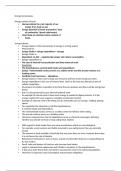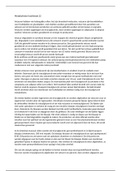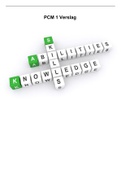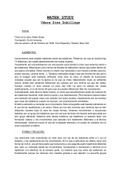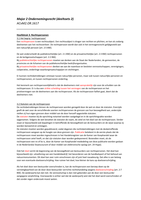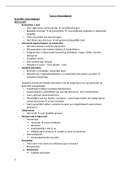Energy homeostasis.
Energy content of food
• Humans obtain the vast majority of our
• energy from food we eat
• Energy potential of foods assessed by ‘heat
• of combustion’ (bomb calorimetry)
• Used today to calculate calorie content of
• foods
energy balance
• Energy balance is the homeostasis of energy in a living system
• Measured by:
• Energy intake = energy expenditure + storage
• Energy intake is:
• Dependent on diet – regulated by hunger and calorie consumption
• Energy expenditure is:
• The sum of internal heat production and inter/external work
• Regulation
• The hypothalamus controls both intake and expenditure:
• Eating - Ventromedial nucleus serves as a satiety centre and the arcuate nucleus as a
feeding centre
• Feedback from hormones – adipokines
• Energy balance is how much energy you consume and how much energy you store.
• Energy expenditure is the sum of internal heat, which is the heat you liberate as part of
cellular respiration.
• (by product of cellular respiration is the heat that you produce and there will be energy loss
there)
• But it is also governed by your internal/external work
• An example of internal work is how much energy is needed to digest proteins. It is the
energy required for your organs to complete a particular function.
• Example of external work is like things you do externally such as running , walking, playing
sports.
• For regulation the integrator is still the hypothalamus
• It controls intake and expenditure.
• The ventromedial nucleus serves as a satiety center for fullness when eating.
• The arcuate nucleus serves as a feeding center
• Hormones released from the fat (adipokines) serve as chemical messengers dictating
whether you should eat food or stop eating food. (leptin)
• With regard to food intake there are some mechanisms which are non-biological.
• For example, social customs and habits may lead to you eating more than you normally
would.
• The amount of food available, historically this may have been an issue, however these days
it is not hence the rate of obesity.
• Behavioural mechanisms, such as stress, anxiety and boredom leads to us eating things we
do not need to.
• Smell, taste and texture of food can also increase food intake.
• Leptin is released from adipocytes and it binds to receptors in the hypothalamus.
• It tells your brain that it does not need to eat anymore, they're by supressing appetite.
• Therefore it supresses food consumption and promotes weightloss.
, • It does this by inhibiting the agalti related peptide and then neuropeptide Y neurones.
• The downstream effects of this is that it will inhibit the apetite enhancing pathway.
• Leptin blocks the appetite enhancing pathway so it tells youre brain that you need to stop
eating.
• Individuals who are genetically obese or they have deficiencies in leptin, the body or the
adipose stores are unable to tell the brain to stop eating.
• Insulin does the same thing.
• Insulin is only released when your body is in the fed state.
• If there is plenty of insulin about you would be inhibiting this pathway aswell.
• Because if you have already eaten you would not want to enhance apetite pathways you
would want to sequester them.
AMPK and energy homeostasis
• AMP-activated protein kinase (AMPK) is a highly evolutionarily conserved
serine/threonine kinase
• AMPK is a heterotrimer complex comprising a catalytic α subunit, with a conventional
serine/threonine protein kinase domain, and two regulatory subunits, β and γ
• AMPK activated via phosphorylation by upstream kinases
• Acts as a key nutrient sensor and metabolic switch
• How energy balance is regulated at a molecular level:
• One of the key ways by which energy homeostasis is bought about is through AMPK.
• AMPK is activated in response to a variety of conditions that deplete cellular energy levels.
• Therefore it functions as a cellular energy sensor.
• If in depleted levels AMPK is activated surely a lack of energy must stimulate its function.
• ATP is our energy unit.
• the precurosors of ATP are ADP and AMP.
• If we are in the monophosphate phase we do not have enough energy because ATP is our
predominant energy source and that is what gives us the most energy.
• When AMP (the absolute precursor of ATP) is knocking around that is when AMPK becomes
active.
• AMPK is a cellular energy sensor.
• AMP is activated protein kinase
• It is activated in situations such as nutrient starvation, particularly glucose (it is very sensitive
to glucose)
• It can also be activated with exposure to certain toxins that inhibit mitochondrial respiratory
chain.
• Function of AMPK is to turn on catabolic pathways, which generate ATP and turn off energy
consuming anabolic pathways.
• When we destroy something we liberate energy but when we build something we consume
energy.
• If you are in a starvation mode:
• You will have less glucose which means you are going to have less ATP.
• ATP to AMP ratio will be altered and there will be more AMP instead.
• In times like this we cannot be enhancing anabolic (anything that builds) pathways.
• AMPK would activate catabolic processes because when we break stuff down we liberate
energy.
• e.g. glycogenlysis- if we are breaking down glycogen we are going to be liberating glucose. If
we liberate glucose we will be releasing energy.
• AMPK is spread around the body
• AMPK upregulates catabolic processes (anything that breaking things down).
Energy content of food
• Humans obtain the vast majority of our
• energy from food we eat
• Energy potential of foods assessed by ‘heat
• of combustion’ (bomb calorimetry)
• Used today to calculate calorie content of
• foods
energy balance
• Energy balance is the homeostasis of energy in a living system
• Measured by:
• Energy intake = energy expenditure + storage
• Energy intake is:
• Dependent on diet – regulated by hunger and calorie consumption
• Energy expenditure is:
• The sum of internal heat production and inter/external work
• Regulation
• The hypothalamus controls both intake and expenditure:
• Eating - Ventromedial nucleus serves as a satiety centre and the arcuate nucleus as a
feeding centre
• Feedback from hormones – adipokines
• Energy balance is how much energy you consume and how much energy you store.
• Energy expenditure is the sum of internal heat, which is the heat you liberate as part of
cellular respiration.
• (by product of cellular respiration is the heat that you produce and there will be energy loss
there)
• But it is also governed by your internal/external work
• An example of internal work is how much energy is needed to digest proteins. It is the
energy required for your organs to complete a particular function.
• Example of external work is like things you do externally such as running , walking, playing
sports.
• For regulation the integrator is still the hypothalamus
• It controls intake and expenditure.
• The ventromedial nucleus serves as a satiety center for fullness when eating.
• The arcuate nucleus serves as a feeding center
• Hormones released from the fat (adipokines) serve as chemical messengers dictating
whether you should eat food or stop eating food. (leptin)
• With regard to food intake there are some mechanisms which are non-biological.
• For example, social customs and habits may lead to you eating more than you normally
would.
• The amount of food available, historically this may have been an issue, however these days
it is not hence the rate of obesity.
• Behavioural mechanisms, such as stress, anxiety and boredom leads to us eating things we
do not need to.
• Smell, taste and texture of food can also increase food intake.
• Leptin is released from adipocytes and it binds to receptors in the hypothalamus.
• It tells your brain that it does not need to eat anymore, they're by supressing appetite.
• Therefore it supresses food consumption and promotes weightloss.
, • It does this by inhibiting the agalti related peptide and then neuropeptide Y neurones.
• The downstream effects of this is that it will inhibit the apetite enhancing pathway.
• Leptin blocks the appetite enhancing pathway so it tells youre brain that you need to stop
eating.
• Individuals who are genetically obese or they have deficiencies in leptin, the body or the
adipose stores are unable to tell the brain to stop eating.
• Insulin does the same thing.
• Insulin is only released when your body is in the fed state.
• If there is plenty of insulin about you would be inhibiting this pathway aswell.
• Because if you have already eaten you would not want to enhance apetite pathways you
would want to sequester them.
AMPK and energy homeostasis
• AMP-activated protein kinase (AMPK) is a highly evolutionarily conserved
serine/threonine kinase
• AMPK is a heterotrimer complex comprising a catalytic α subunit, with a conventional
serine/threonine protein kinase domain, and two regulatory subunits, β and γ
• AMPK activated via phosphorylation by upstream kinases
• Acts as a key nutrient sensor and metabolic switch
• How energy balance is regulated at a molecular level:
• One of the key ways by which energy homeostasis is bought about is through AMPK.
• AMPK is activated in response to a variety of conditions that deplete cellular energy levels.
• Therefore it functions as a cellular energy sensor.
• If in depleted levels AMPK is activated surely a lack of energy must stimulate its function.
• ATP is our energy unit.
• the precurosors of ATP are ADP and AMP.
• If we are in the monophosphate phase we do not have enough energy because ATP is our
predominant energy source and that is what gives us the most energy.
• When AMP (the absolute precursor of ATP) is knocking around that is when AMPK becomes
active.
• AMPK is a cellular energy sensor.
• AMP is activated protein kinase
• It is activated in situations such as nutrient starvation, particularly glucose (it is very sensitive
to glucose)
• It can also be activated with exposure to certain toxins that inhibit mitochondrial respiratory
chain.
• Function of AMPK is to turn on catabolic pathways, which generate ATP and turn off energy
consuming anabolic pathways.
• When we destroy something we liberate energy but when we build something we consume
energy.
• If you are in a starvation mode:
• You will have less glucose which means you are going to have less ATP.
• ATP to AMP ratio will be altered and there will be more AMP instead.
• In times like this we cannot be enhancing anabolic (anything that builds) pathways.
• AMPK would activate catabolic processes because when we break stuff down we liberate
energy.
• e.g. glycogenlysis- if we are breaking down glycogen we are going to be liberating glucose. If
we liberate glucose we will be releasing energy.
• AMPK is spread around the body
• AMPK upregulates catabolic processes (anything that breaking things down).

